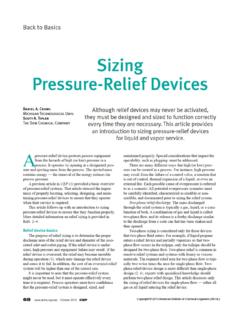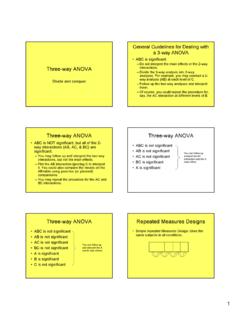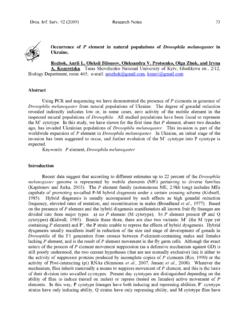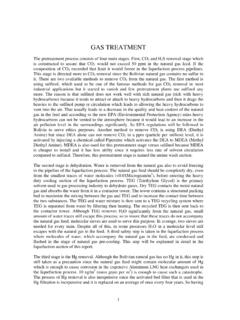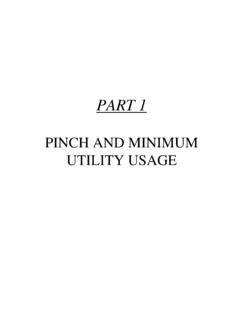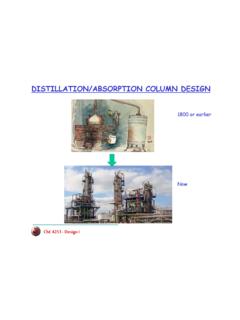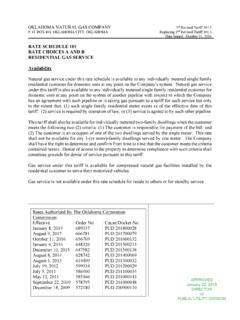Transcription of Pipeline Engineering - University of Oklahoma
1 Pipeline Engineering . FLUID FLOW. Mechanical Energy Balance V 2 .. g z + vdp + = Wo . 2 . F (1-1). potential energy expansion work Kinetic energy Work added/ Sum of friction change change subtracted by losses compressors or pumps/expanders Note that the balance is per unit mass. In differential form gdz + vdp + VdV = Wo F (1-2). Rewrite as follows dp = ( g dz V dV F + Wo ) (1-3). Divide by dL (L is the length of pipe). dp dz dV F W. = g + V + o (1-4). dL Tot dL dL L L. or: dp dp dp dp . = + + (1-5). dL Tot dL elev dL accel dL frict Wo ( is usually ignored, as the equation applies to a section of pipe).
2 L. The above equation is an alternative way of writing the mechanical energy balance. It is not a different equation. The differential form of the potential energy change is dL. dZ. dZ. g = g sin (1-6). dL. Friction losses: We use the Fanning or Darcy-Weisbach equation (Often called Darcy equation). 2V 2 f F = dL (1-7). D. an equation that applies for single phase fluids, only (two phase fluids are treated separately). The friction factor, in turn, is obtained from the Moody Diagram below. Figure 1-1: Moody Diagram Friction factor equations. (Much needed in the era of computers and excel).
3 16. Laminar Flow f = (1-8). Re Natural Gas Basic Engineering 2 Copyright: Miguel Bagajewicz. No reproduction allowed without consent Turbulent Flow f = (1-9). Re a smooth pipes: a=0. Iron or steel pipes a= 1 . Turbulent Flow = 2 log10 + (Colebrook eqn) (1-10). f D Re f . Equivalent length of valves and fittings: Pressure drop for valves and fittings is accounted for as equivalent length of pipe. Typical values can be obtained from the following Table. Table 1-1: Equivalent lengths for various fittings. Le Fitting D. 45O elbows 15. 90O elbows, std radius 32. 90O elbows, medium radius 26.
4 90O elbows, long sweep 20. 90O square elbows 60. 180O close return bends 75. 180O medium radius return bends 50. Tee (used as elbow, entering run) 60. Tee (used as elbow, entering branch) 90. Gate Valve (open ) 7. Globe Valve (open ) 300. Angle Valve (open) 170. Pressure Drop Calculations Piping is known. Need pressure drop. (Pump or compressor is not present.). Incompressible Flow a) Isothermal ( is constant). dp dZ dV dF . = - g +V + (1-11). dL Tot dL dL dL . for a fixed V constant dV = 0. Natural Gas Basic Engineering 3 Copyright: Miguel Bagajewicz. No reproduction allowed without consent L.
5 F = 2V 2 f (1-12). D .. L. p = g Z + 2V 2 f + F (1-13). D . b) Nonisothermal It will not have a big error if you use (Taverage), v(Taverage). Exercise 1-1: Consider the flow of liquid water (@ 20oC) through a 200 m, 3 pipe, with an elevation change of 5 m. What is the pressure drop? Can the Bernoulli equation assuming incompressible flow be used for gases? The next figure illustrates it. Natural Gas Basic Engineering 4 Copyright: Miguel Bagajewicz. No reproduction allowed without consent Figure 1-2: Error in Bernoulli equation pout pin In conclusion, if using the assumption of incompressibility is OK.
6 Pin Compressible Flow (Gases). a) Relatively small change in T (known). Natural Gas Basic Engineering 5 Copyright: Miguel Bagajewicz. No reproduction allowed without consent For small pressure drop (something you can check after you are done) can use Bernoulli and fanning equation as flows V 2 . gdz + vdp + d = -dF (1-14). 2 . Then g 1 V dF. 2. dz + dp + 2 dV = - 2 (1-15). v v v v G. but V = v , where A. V = Velocity (m/sec). v = Specific volume (m3/Kg). G = Mass flow (Kg/sec). A = Cross sectional area (m2). Then, 2. g 1 G dV dF G dL. dz + dp + = - 2 = -2f (1-16). A v A D.
7 2. v v v Now put in integral form 2 2. dp G . dz dV G 1.. g 2+. v + . v A V. = 2 f dL. A D (1-17). Assume Tin +Tout Tav = (1-18). 2. out 2 p p . pav = pin + pout in out which comes from pav =. in p p dp (1-19). 3 pin + pout out in p dp f(Tin ,Pin )+ f(Tout ,Pout ). f av = (1-20). 2. The integral form will now be Natural Gas Basic Engineering 6 Copyright: Miguel Bagajewicz. No reproduction allowed without consent 2 2. out dp G Vout G L. 2av g z + + ln = 2 f av (1-21). in v A Vin A D. Z R T p M. Now use p v = , where M: Molecular weight. Then av = av , which leads to: M Z av R Tav.
8 Dp =. M. v Z av RTav p dp = 2 Z. M. RT. ( 2. pout pin2 ) = av ( pout 2 p 2. pin2 ) (1-22). av av av Therefore;. 2 2. av G V G . g z +. 2. av 2 pav (p 2. out p ) + ln out = 2 f av 2. in A Vin A . L. D. (1-23). but, Vout Zout Tout pin = (1-24). Vin Zin Tin pout Then 2 2. av G Z T p G . g z +. 2. av 2 pav (p 2. out p ) + ln out out in = 2 f av 2. in A Z in Tin pout A . L. D. (1-25). To calculate Zav Kay's rule is used. This rule states that the reduced pressure and temperature of the gas is obtained using the average pressure and temperature (as above calculated) and a pseudo critical pressure and temperature.
9 P pr = av, (1-26). pC. T. Tr = av, (1-27). TC. In turn the critical pressure and temperatures are obtained as molar averages of the respective components critical values. pC, = yi pC ,i (1-28). i T = yiTC ,i C. , (1-29). i With these values the Z factor comes from the following chart: Natural Gas Basic Engineering 7 Copyright: Miguel Bagajewicz. No reproduction allowed without consent Figure 1-3: Natural Gas Compressibility Chart Equation (1-25) can be further simplified. First neglect the acceleration term because it is usually small compared to the others, to obtain: Natural Gas Basic Engineering 8 Copyright: Miguel Bagajewicz.
10 No reproduction allowed without consent 2. av G . av2 g z +. 2 pav (p 2. out ) A . L. pin2 + 2 f av = 0. D. (1-30). Form this equation we can get G, as follows: M 2 pav2 . g z . G2 =. D 2 M (. 5 p 2. in p 2. out ) Z RT. av av (1-31). 32 f av L 2 Z av RTav Z av RTav .. G. But the volumetric flow at standard conditions is given by ps Q = Z s RTs where the M. subscript s stands for standard conditions. Therefore: 2 M pav2 . 2 . R Z s Ts . 2 2. pin p 2. out (. 2 ). Z av RTav g z 5. Q2 = D (1-32). 32 Mps 2. 2 Z avTav L f av .. Now, if z =0, we get 2 R Z s2 Ts2 ( pin pout ) D 5.
